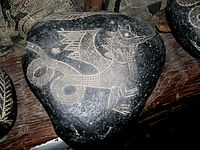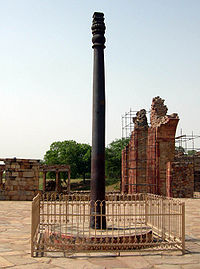- Out-of-place artifact
-
Out-of-place artifact (OOPArt) is a term coined by American naturalist and cryptozoologist Ivan T. Sanderson for an object of historical, archaeological, or paleontological interest found in a very unusual or seemingly impossible context[1] that could challenge conventional historical chronology.
The term "out-of-place artifact" is rarely used by mainstream historians or scientists. Its use is largely confined to cryptozoologists, proponents of ancient astronaut theories, Young Earth creationists, and paranormal enthusiasts.[2] The term is used to describe a wide variety of objects, from anomalies studied by mainstream science to pseudoarchaeology far outside the mainstream, to objects that have been shown to be hoaxes or to have mundane explanations.
Critics argue that most purported OOPArts which are not hoaxes are the result of mistaken interpretation, wishful thinking, or a mistaken belief that a particular culture couldn't have created an artifact or technology due to a lack of knowledge or materials. Supporters regard OOParts as evidence that mainstream science is overlooking huge areas of knowledge, either willfully or through ignorance.[2]
In some cases, the uncertainty results from inaccurate descriptions. For example: the Wolfsegg Iron was said to be a perfect cube, but in fact it is not; the Klerksdorp spheres were said to be perfect spheres, but they are not; and the Iron pillar of Delhi was said to be stainless, but it has some rust near its base.
Many writers or researchers who question conventional views of human history have used purported OOPArts in attempts to bolster their arguments; they are used to support religious descriptions of pre-history, ancient astronaut theories, or the notion of vanished civilizations that possessed knowledge or technology more advanced than our own.[2]
Contents
Validation
In rare cases, the validity of claims is validated by mainstream science; i.e., it is proven that some artifact was created with a technology not previously thought to have existed in the ancient culture that built it. One piece that changed mainstream understanding of ancient technology is the Antikythera mechanism, a type of mechanical computer[3][4] which has been fully validated as a real object from about 150–100 BC. Before X-ray examination, its clockwork-like appearance (dating about 1,000 years before clocks were invented) was cited as evidence of alien visitation by fringe sources.[5]
A partially validated example is the Maine penny, from the Goddard site in Blue Hill, Maine, United States. It is an 11th century Norse coin found in an American Indian shell midden. Over 20,000 objects were found over a 15-year period at the site. The sole non-Native artifact was the coin.[6] Some argue it demonstrates Norse visits to North America unknown to archaeology; mainstream belief is that it was brought to the site from Labrador or Newfoundland by native trade.[7]
Examples
These are examples of objects that have been argued by various fringe authors (see list) to have been OOPArts. They are categorised according to their current status in the eyes of the mainstream scientific community (for references on this, see the linked article on each item). Here "validation" means that the object in question has been validated as evidence of technological developments that were present in an ancient society and which were previously unknown to us.
Entirely fictional
- Dropa stones: Invented by David Gamon (as David Agamon) as part of his false document Sungods in Exile.
Probably debunked
Modern-day creations
- Acámbaro figures: Mid-20th century figurines of dinosaurs, attributed by Waldemar Julsrud to an ancient society.
- Crystal skulls: supposedly demonstrate more advanced stonecutting skills than were available in pre-Columbian South America. Appear to have been made in the 19th century.
- Ica stones: Depict Inca dinosaur-hunters, surgery, and other modern or fanciful topics. Collected by Javier Cabrera Darquea who believed them to be prehistoric.
- Kensington Runestone: Purports to have been made by 15th century descendents of Leif Ericson's colony. Generally believed to be a modern-day hoax.
Natural objects mistaken for artifacts
- Baigong Pipes: Their natural vs artificial status is uncertain; see the article for details.
- Eltanin Antenna: Actually a sponge
- Klerksdorp spheres: Actually Precambrian concretions
Erroneously dated objects
- Coso artifact: Thought to be prehistoric; actually a 1920s spark plug.
- Malachite Man: Thought to be from the early Cretaceous; actually a post-Columbian burial.
- Wolfsegg Iron: Thought to be from the Tertiary epoch; actually from an early mining operation. Inaccurately described as a perfect cube.
Unconfirmed objects
- Dorchester Pot: a metal pot claimed to have been blasted out of solid rock in 1852.
- Kingoodie artifact: an object resembling a corroded nail, said to have been encased in solid rock.
- Fuente Magna: A bowl with what appears to be a Sumerian inscription on it, but was found in Tiwanaku.
Unorthodox interpretations of real ancient artifacts
- Baalbek megaliths: Supposedly impossible to move with Bronze Age technology.
- Dendera Lamps: supposed to depict a light bulb, but made in Ptolemaic Egypt.
- Iron Man (Eiserne Mann): an old iron pillar, said to be a unique oddity in Central Europe.
- Iron pillar of Delhi: supposedly demonstrates more advanced metallurgy than was available in 1st millennium India.
- Nazca Lines: supposedly impossible to design without the aid of an aerial view.
- Pacal's sarcophagus lid: Described by Erich von Däniken as a depiction of a spaceship.
- Piri Reis map: several ancient astronauts authors, and others such as Gavin Menzies, suggested that this map, made by the Turkish admiral Piri Reis from a diverse range of sources centuries before the Antarctica was discovered, features that continent and even has many points of continuity with modern maps of the Antarctica below its ice sheets.
- Saqqara Bird: supposed to depict a glider, but made in Ancient Egypt.
- Shakōkidogū: small humanoid and animal figurines made during the late Jōmon period (14,000 –400 BCE) of prehistoric Japan, said to resemble extraterrestrial astronauts.
- Stone spheres of Costa Rica: inaccurately described as perfectly spherical, and therefore as demonstrating greater stoneworking skills than were available in pre-Columbian times.
Formerly orthodox interpretations of artifacts
- Baghdad Battery: Vase and rods made in Parthian or Sassanid Persia. May have been used as a galvanic cell for electroplating, though no electroplated artifacts from this era have been found.
- Lake Winnipesaukee mystery stone: Originally thought to be a record of a treaty between tribes; but later analysis has called its authenticity into question.
Partially validated
- Maine penny: May be a sign of pre-Columbian contact.
- Tecaxic-Calixtlahuaca head: said to be a bust in the Classical Roman style, found in a Mexican tomb.
Fully validated
- Antikythera mechanism: a set of gears from an orrery, dating to the 2nd century BC.
See also
- Ancient technology
- Anachronism
- Pseudoarchaeology
- Occam's razor advocates that the simplest solution is most often right
Authors and works:
- Charles Fort, researcher of anomalous phenomena
- Fortean Times
- Peter Kolosimo
- Erich von Däniken, the most famous ancient astronauts theorist
-
- Chariots of the Gods?, one of his notable works
- Zecharia Sitchin
- Fingerprints of the Gods book by Graham Hancock
- Michael Cremo, author of several books including Forbidden Archeology
- Andrew Tomas, author of several books, including We Are Not the First
- The Mysterious Origins of Man originally aired on NBC in 1996
References
- ^ Hatcher Childress, David (1996). Lost cities of Atlantis, ancient Europe & the Mediterranean. Adventures Unlimited Press. ISBN 0932813259. http://books.google.com/books?id=eDSFkAghU34C&pg=PA171&lpg=PA171&dq=%22Ivan+T.+Sanderson%22+OOPart&ct=result#v=onepage&q=%22Ivan%20T.%20Sanderson%22%20OOPart&f=false. Retrieved April 19, 2010.
- ^ a b c O'Hehir, Andrew (Wednesday, Aug 31, 2005). "Archaeology from the dark side". Salon.com. http://www.salon.com/news/feature/2005/08/31/archaeology/index.html. Retrieved 19 April 2010.
- ^ "The Antikythera Mechanism Research Project", The Antikythera Mechanism Research Project. Retrieved 2007-07-01 Quote: "The Antikythera Mechanism is now understood to be dedicated to astronomical phenomena and operates as a complex mechanical "computer" which tracks the cycles of the Solar System."
- ^ Paphitis, Nicholas (December 1, 2006). "Experts: Fragments an Ancient Computer". The Washington Post (ATHENS, Greece). http://www.washingtonpost.com/wp-dyn/content/article/2006/11/30/AR2006113001303.html. "Imagine tossing a top-notch laptop into the sea, leaving scientists from a foreign culture to scratch their heads over its corroded remains centuries later. A Roman shipmaster inadvertently did something just like it 2,000 years ago off southern Greece, experts said late Thursday."
- ^ "The Antikythera Mechanism". Skeptoid.com. http://skeptoid.com/episodes/4184. Retrieved 2011-08-24.
- ^ "Bye, Columbus". Time. December 11, 1978. http://www.time.com/time/magazine/article/0,9171,919916,00.html.
- ^ "Vinland Archeology". Smithsonian Institution National Museum of Natural History. http://www.mnh.si.edu/vikings/voyage/subset/vinland/archeo.html. Retrieved 2011-08-24.
External links
Against OOPArts
- Bad Archaeology, critical perspective on Creationist and New Age claims related to out-of-place artifacts
- Salon article: Archaeology from the dark side
- Out-of-place artifacts article from Cult and Fringe Archaeology website
Categories:- Out-of-place artifacts
- Forteana
- Pseudoarchaeology
Wikimedia Foundation. 2010.


